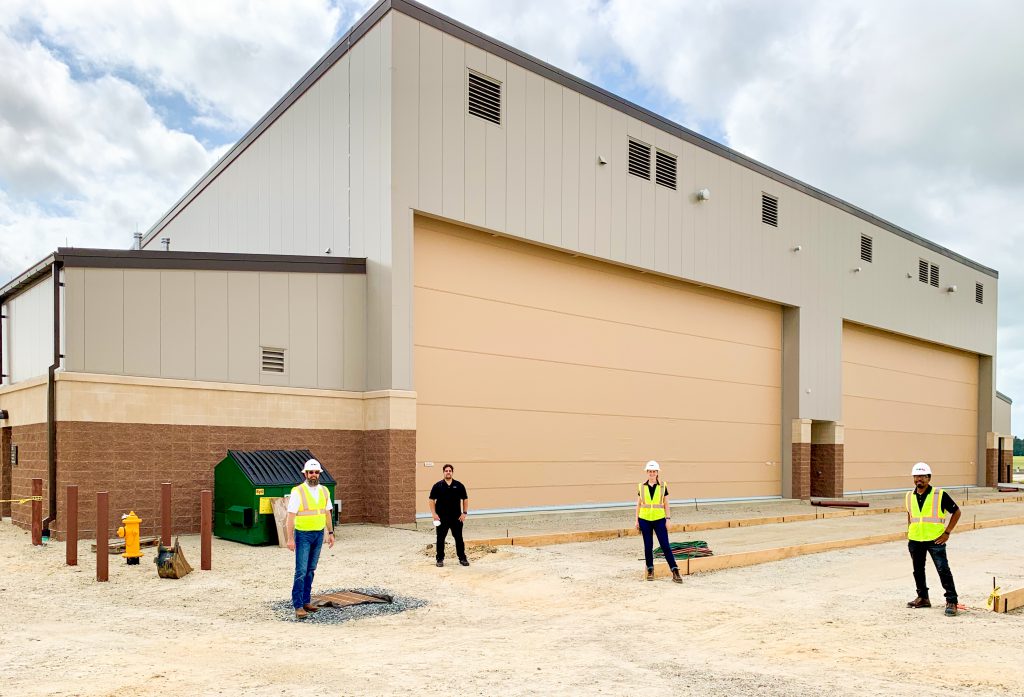By R. Chris Jenkins, P.E., LEED AP, M.SAME
The 177th Fighter Wing, based at Atlantic City International Airport in Egg Harbor Township, N.J., traces its origins back to 1917 as the 119th Aero Squadron. Like other elements of the New Jersey Air National Guard (NJANG), the 177th is an air combat command unit that provides mission- ready citizen-airmen and equipment to support national and state objectives, provide homeland defense, and worldwide deployable forces when called upon. Meeting its mission to be “Already Ready, Always There!” requires that members of the 177th have quick access to aircraft that are in operational readiness and equipped to meet evolving challenges. That demands state-of-the-art, 24/7 maintenance and flexible hangars capable of meeting the needs of today’s modern aircraft as well as those being imagined, designed, and developed for the future.
In the wing’s existing facilities, fuel cell maintenance and corrosion control were being performed in separate buildings that were not designed to support these activities. A recent project consolidated these functions into a single facility that meets the unique needs of these maintenance activities and adheres to Unified Facilities Criteria.
The expanded building footprint also provides for future growth potential, with the inclusion of enhanced hangar bays designed to accommodate the additional aircraft of tomorrow.

PHOTO COURTESY POND
KEEPING THEM FLYING
The mission aircraft of the 177th is the single-seat F-16C Fighting Falcon—an advanced aerial combat aircraft that entered service in 1979 and provides fourth-generation fighter aircraft capabilities. Keeping these assets in mission-ready condition necessitates ongoing maintenance and repairs. From essential aircraft-specific safety checks to critical fuel cell/corrosion control and unscheduled repairs requiring service specialty codes, this work ensures airmen can deploy anywhere, at any time, while executing their domestic missions.
At the start of the project, NJANG and Pond discussed the initial needs and challenges of the facility. To successfully execute the mission, technicians need to be able to repair and manage the aircraft’s fuel storage components. This includes the fuel storage tanks and interior bladders, as well as the hoses and components that circulate fuel. Additionally, the hangar had to ensure corrosion control could be facilitated, which involves the maintenance of the aircraft exterior. Without this, the integrity of the paint and miscellaneous exterior coatings would be compromised.
Fuel cell maintenance and corrosion control operations emit harmful fumes and chemicals. To ensure worker safety, ventilation in the hangar bays provide for a minimum number of air changes per hour, in accordance with Unified Facilities Criteria. In addition, changing rooms with a vestibule allow workers to discard dirty clothing and progress into the shower and locker room without contaminating the adjacent administrative areas.
DESIGNED FOR SAFETY
Following a thorough planning assessment, the project team produced a design that meets the needs of the current aircraft and anticipates those of the fifth generation of fighter aircraft. A project- specific quality control plan was developed and implemented, to include steps for peer, client, and independent technical reviews on all project submittals. The plan was designed to secure adherence with DD Form 1391 and incorporate industry best practices, military design criteria, and applicable codes.
The new hangar would require two bays sized to fit in the limited airfield space of 21,100-ft² while avoiding jet blasts from the nearby runway. Jet blasts from the F-16 were analyzed carefully given the close proximity to adjacent runways and taxiways. A particular concern was the upward-acting fabric door of the hangar bays facing the potential jet blast. Upward acting fabric doors have a vinyl exterior sheathing, which could potentially melt if the temperature gets too high. The analysis of the jet blast effects on building materials guided the location and building envelope design. In addition, a jet blast fence was installed to protect both the envelope and workers in the ramp area. This location and design met Federal Aviation Administration Part 77 clear zone requirements.
The two-bay hangar was designed to provide fuel cell and corrosion-control maintenance with fuel cell tools and equipment shops and tank maintenance spaces. Areas for parts washing, paint stripping, and a paint booth were also provided. The client emphasized that the fabric door design of the new hangar had to conform to the other hangars on site; as a result, the same upward-acting fabric doors were installed. These doors provide easy maintenance compared to the traditional rolling doors.
The concept floorplan was designed to meet the federal construction handbook’s building codes, including DD Form 1391, Air National Guard Engineering Technical Letters, and local standards. Additionally, it meets all UFC 4-010-01 requirements for antiterrorism/force protection design for an inhabited facility, establishing a minimum setback for parking. Interior design features for the administrative and training rooms were performed in accordance with ANGETL requirements.
Mechanical systems were developed in compliance with Class 1, Division 1 ratings due to fuel-laden air hazard. Systems included heated make-up air, exhaust systems, and local heaters. A high expansion foam system was installed in both hangar bays in accordance with ANGETL and UFC criteria.
The design team conceived aircraft access aprons and taxiways to accommodate towed aircraft movement into and out of the two-bay maintenance hangar. Taxiway connection tied into an existing aircraft parking apron, requiring detailed drawings and specifications relating to doweling, joint sealants, and striping.
AN EYE TO THE FUTURE
A key component to carrying out this project was the development of strong client relationships. The new facility meets all federal requirements and achieved LEED Silver certification.
Thanks to this new facility, NJANG will be equipped to not only support its current aircraft, but beddown larger aircrafts in the future. In this way, the 177th remains “Always Ready, Always There!” to carry out its evolving mission in support of national defense, both across the homeland and abroad.
Related Posts
-

Reversing the Shrinking Industrial Base
Incentivizing companies to remain as advanced small businesses, without needing to transition to the large fully open competition market, coupled with difficulties for new small businesses to enter federal acquisition, has resulted in a steady pattern of decline in the nation’s defense industrial base, carrying with it risks to innovation, global standing, and national security. -

Fulfilling the Mission
Rear Adm. Dean VanderLey, CEC, USN, Commander, Naval Facilities Engineering Systems Command, sits down with TME to discuss the Department of the Navy’s Systems Command for shore facilities and expeditionary equipment, Naval Facilities Engineering Systems Command (NAVFAC) and its varied responsibility that directly support warfighter lethality. -

A Roadmap for Clean Energy on Kwajalein Atoll
A recent effort led by U.S. Army Space & Missile Defense Command to meet the Army Climate Strategy for operations on Kwajalein Atoll studied potential courses of action that would help the remote installation reach 100 percent carbon-pollution free electricity by 2030.